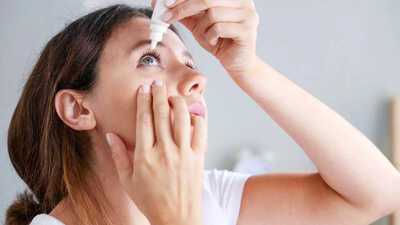Feeling constant eye irritation, burning, or blurred vision after long hours on your phone or laptop? You might be experiencing dry eye disease , a fast-growing modern condition linked to excessive screen time, pollution, and even air conditioning. Once considered a minor inconvenience, it's now recognised as a chronic issue that can affect daily productivity and long-term eye health. Urban lifestyles, digital overload, and poor blinking habits are all culprits. But the good news? Science-backed solutions exist. In this article, we break down what dry eye disease really is, why it’s becoming so common, and how to treat and prevent it effectively.
What is dry eye disease?

Dry eye disease occurs when your eyes either don’t produce enough tears or the tears evaporate too quickly. This leads to symptoms like dryness, irritation, a gritty sensation, or even blurred vision. But it's more than just lack of moisture. According to the TFOS DEWS II Report (2017), dry eye is a complex medical condition involving an unstable tear film, ocular surface inflammation, and in some cases, nerve dysfunction. These factors disrupt normal tear production and eye lubrication, making the condition chronic and often progressive if left untreated.
Why is dry eye disease becoming so common?

In today's digital-first, urban lifestyle, dry eye disease is rapidly becoming one of the most widespread eye conditions worldwide. But why are more people, especially young adults and even children, experiencing dry, irritated eyes? Here are the top scientifically proven reasons:
Too much screen time
Staring at phones, laptops, and TVs for long periods significantly reduces your blink rate, causing your tears to evaporate more quickly. This leads to unstable tear film and increased eye dryness. A study by Moon et al. (2023) revealed that even school children who use digital devices frequently are showing early signs of dry eye disease, pointing to how screen overuse is affecting eye health from a young age.
Pollution in the air
Airborne pollutants especially PM₂.₅, ozone (O₃), and sulfur dioxide (SO₂) can damage the ocular surface, destabilise your tear film, and trigger chronic inflammation. A large multicenter study by Ran Hao et al. (Frontiers in Medicine, 2022) demonstrated that exposure to these air pollutants was strongly associated with meibomian gland dysfunction, elevated tear cytokine levels, and worsening dry eye symptoms in urban patients.
Meibomian gland dysfunction (MGD)
Your eyelids contain meibomian glands that secrete oils essential for preventing your tears from evaporating too fast. When these glands become clogged or inflamed, they can no longer protect the tear film effectively, causing evaporative dry eye the most common subtype of dry eye disease today.
Other factors
What are the symptoms of dry eye disease?
Not sure if you have it? Watch out for these common symptoms:
How to treat dry eye disease

The good news? You can manage dry eye disease with a mix of home care and medical treatments. Here's what works:
Artificial tears
Over-the-counter artificial tears are often the first line of treatment for dry eye disease. They help replenish moisture on the surface of the eye and relieve symptoms like burning, stinging, and grittiness. For long-term use, it's best to choose preservative-free variants, as preservatives in some eye drops can cause irritation when used too often. These drops can be used several times a day and are especially helpful after prolonged screen time, exposure to wind, or air-conditioned environments.
Warm compresses
Applying a warm compress over closed eyelids helps to melt the thickened oil in the Meibomian glands, which are responsible for producing the oily layer of your tear film. When these glands get clogged, it leads to quicker evaporation of tears. Use a clean, warm towel or a microwavable eye mask for 5–10 minutes daily. This not only promotes better oil flow but also soothes inflammation and improves overall comfort, especially for those with Meibomian Gland Dysfunction (MGD).
Lid hygiene
Proper eyelid hygiene is crucial for managing dry eye, especially if you have blepharitis or oil gland issues. Cleaning your eyelids daily helps remove debris, dead skin, and bacteria that can cause inflammation. Use a doctor-recommended lid scrub, diluted baby shampoo, or pre-moistened sterile wipes. Gently clean the base of your eyelashes with a cotton pad or swab. Consistent lid hygiene reduces flare-ups, stabilises the tear film, and improves overall eye comfort.
Omega-3 fatty acids
Multiple studies have shown that omega-3 supplements, especially those containing EPA and DHA can significantly improve dry eye symptoms by enhancing the quality of oil in your tears. These healthy fats reduce inflammation and support Meibomian gland function. Sources include fish oil capsules, flaxseed oil, chia seeds, and walnuts. Talk to your doctor about dosage, as high-quality supplements may be more effective. They’re not a quick fix, but over time, they can be a game-changer for dry eye relief.
Prescription eye drops
For moderate to severe dry eye cases, your doctor may prescribe medicated eye drops like cyclosporine (Restasis) or lifitegrast (Xiidra). These work by targeting the inflammation in the tear glands and improving natural tear production. Unlike artificial tears, these drops take a few weeks to show results but address the root cause of chronic dry eye. They’re especially effective in autoimmune-related cases or when standard over-the-counter drops are not enough.
Environmental changes
Dry eye disease is more than just an uncomfortable feeling, it’s a real medical condition made worse by modern habits and pollution. The good news? With science-backed treatments and small lifestyle changes, you can get long-term relief and protect your eye health. Don’t ignore the signs your eyes are trying to tell you something!
Also read| 7,000 steps a day can reduce the risk of diseases like cancer, dementia, and heart problems
What is dry eye disease?

Dry eye disease occurs when your eyes either don’t produce enough tears or the tears evaporate too quickly. This leads to symptoms like dryness, irritation, a gritty sensation, or even blurred vision. But it's more than just lack of moisture. According to the TFOS DEWS II Report (2017), dry eye is a complex medical condition involving an unstable tear film, ocular surface inflammation, and in some cases, nerve dysfunction. These factors disrupt normal tear production and eye lubrication, making the condition chronic and often progressive if left untreated.
Why is dry eye disease becoming so common?
In today's digital-first, urban lifestyle, dry eye disease is rapidly becoming one of the most widespread eye conditions worldwide. But why are more people, especially young adults and even children, experiencing dry, irritated eyes? Here are the top scientifically proven reasons:
Too much screen time
Staring at phones, laptops, and TVs for long periods significantly reduces your blink rate, causing your tears to evaporate more quickly. This leads to unstable tear film and increased eye dryness. A study by Moon et al. (2023) revealed that even school children who use digital devices frequently are showing early signs of dry eye disease, pointing to how screen overuse is affecting eye health from a young age.
Pollution in the air
Airborne pollutants especially PM₂.₅, ozone (O₃), and sulfur dioxide (SO₂) can damage the ocular surface, destabilise your tear film, and trigger chronic inflammation. A large multicenter study by Ran Hao et al. (Frontiers in Medicine, 2022) demonstrated that exposure to these air pollutants was strongly associated with meibomian gland dysfunction, elevated tear cytokine levels, and worsening dry eye symptoms in urban patients.
Meibomian gland dysfunction (MGD)
Your eyelids contain meibomian glands that secrete oils essential for preventing your tears from evaporating too fast. When these glands become clogged or inflamed, they can no longer protect the tear film effectively, causing evaporative dry eye the most common subtype of dry eye disease today.
Other factors
- Aging and hormonal changes (especially in women)
- Medical conditions like diabetes and autoimmune diseases
- Medications like antidepressants, antihistamines, acne pills
What are the symptoms of dry eye disease?
Not sure if you have it? Watch out for these common symptoms:
- Burning or stinging in the eyes
- Redness or irritation
- Blurry or fluctuating vision
- Eyes that water too much (sounds odd but it’s a response to dryness!)
- Eye fatigue, especially after using screens
How to treat dry eye disease
The good news? You can manage dry eye disease with a mix of home care and medical treatments. Here's what works:
Artificial tears
Over-the-counter artificial tears are often the first line of treatment for dry eye disease. They help replenish moisture on the surface of the eye and relieve symptoms like burning, stinging, and grittiness. For long-term use, it's best to choose preservative-free variants, as preservatives in some eye drops can cause irritation when used too often. These drops can be used several times a day and are especially helpful after prolonged screen time, exposure to wind, or air-conditioned environments.
Warm compresses
Applying a warm compress over closed eyelids helps to melt the thickened oil in the Meibomian glands, which are responsible for producing the oily layer of your tear film. When these glands get clogged, it leads to quicker evaporation of tears. Use a clean, warm towel or a microwavable eye mask for 5–10 minutes daily. This not only promotes better oil flow but also soothes inflammation and improves overall comfort, especially for those with Meibomian Gland Dysfunction (MGD).
Lid hygiene
Proper eyelid hygiene is crucial for managing dry eye, especially if you have blepharitis or oil gland issues. Cleaning your eyelids daily helps remove debris, dead skin, and bacteria that can cause inflammation. Use a doctor-recommended lid scrub, diluted baby shampoo, or pre-moistened sterile wipes. Gently clean the base of your eyelashes with a cotton pad or swab. Consistent lid hygiene reduces flare-ups, stabilises the tear film, and improves overall eye comfort.
Omega-3 fatty acids
Multiple studies have shown that omega-3 supplements, especially those containing EPA and DHA can significantly improve dry eye symptoms by enhancing the quality of oil in your tears. These healthy fats reduce inflammation and support Meibomian gland function. Sources include fish oil capsules, flaxseed oil, chia seeds, and walnuts. Talk to your doctor about dosage, as high-quality supplements may be more effective. They’re not a quick fix, but over time, they can be a game-changer for dry eye relief.
Prescription eye drops
For moderate to severe dry eye cases, your doctor may prescribe medicated eye drops like cyclosporine (Restasis) or lifitegrast (Xiidra). These work by targeting the inflammation in the tear glands and improving natural tear production. Unlike artificial tears, these drops take a few weeks to show results but address the root cause of chronic dry eye. They’re especially effective in autoimmune-related cases or when standard over-the-counter drops are not enough.
Environmental changes
- Use a humidifier
- Avoid dry air or direct AC
- Follow the 20-20-20 rule: every 20 minutes, look at something 20 feet away for 20 seconds
Dry eye disease is more than just an uncomfortable feeling, it’s a real medical condition made worse by modern habits and pollution. The good news? With science-backed treatments and small lifestyle changes, you can get long-term relief and protect your eye health. Don’t ignore the signs your eyes are trying to tell you something!
Also read| 7,000 steps a day can reduce the risk of diseases like cancer, dementia, and heart problems
You may also like

Mock the Week star admits harsh filming reality that drained BBC cast

Viktor Gyokeres lists five reasons he chose Arsenal as Gunners finally complete transfer

'Act East Policy': India sends humanitarian assistance of 5 MT Black-eyed Cowpea Seeds to Fiji

10 CM Rise Schools Near Completion In Indore: Set To Benefit 55,000 Students; Focus On Quality Infrastructure

How to make the viral bread kunafa at home in minutes





